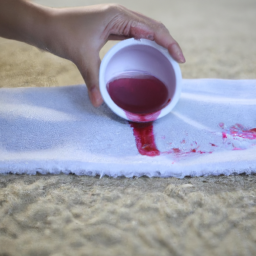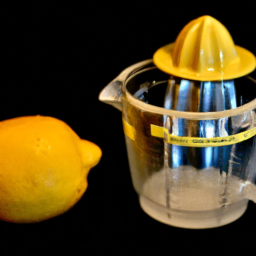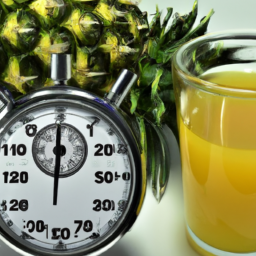As a homeowner, I sympathize with the frustration of accidentally spilling something on the carpet. Juice stains, whether from a spilled glass of orange juice or a burst grape juice box, can be quite difficult to remove.
But fear not, with the right techniques and tools, you can easily get the juice stain out of your carpet. In this article, I will walk you through step-by-step on how to remove a juice stain from your carpet. From preparing a cleaning solution to trying an enzyme cleaner, I will cover all the necessary methods to get rid of the stain.
By following these tips, you’ll be able to restore your carpet to its original clean and fresh state. So, let’s get started on tackling that pesky juice stain!
Key Takeaways
- Act quickly to remove the stain by blotting with cold water.
- Use a cleaning solution of vinegar and baking soda, tested on a small area first.
- Enzyme cleaners can be effective for tough stains.
- Prevention measures like spill-proof cups and carpet protectors can save money and extend the life of your carpet.
Act Quickly
You need to act fast and get that juice stain out of your carpet as soon as possible, using a clean cloth and some cold water.
Carpet maintenance is essential to keep your home looking its best. Stain prevention is a key part of this process, and it’s important to take quick action when accidents happen.
When you notice a juice stain on your carpet, grab a clean cloth and blot the area as soon as possible. Be sure to use cold water to avoid setting the stain in further. Blotting, rather than rubbing, will help prevent the stain from spreading.
Once you’ve removed as much of the juice as possible, it’s time to prepare a cleaning solution.
Prepare a Cleaning Solution
Believe it or not, mixing certain household items together can create a powerful cleaning solution for your carpet. When dealing with juice stains, I recommend using natural cleaning solutions instead of harsh chemicals. One effective solution is a mixture of vinegar and baking soda. Here’s how to make it:
- Mix equal parts white vinegar and water in a spray bottle.
- Sprinkle baking soda over the stained area and let it sit for a few minutes.
- Spray the vinegar solution onto the baking soda and let it fizz.
- Blot the stain with a clean cloth, working from the outside in.
This combination of vinegar and baking soda works wonders for lifting stains and neutralizing odors. However, it’s important to test the solution on a small, inconspicuous area of the carpet first to make sure it doesn’t cause any damage.
Test the Solution
Before applying the cleaning solution, it is crucial to test it on a small and inconspicuous area of the carpet to avoid any potential damage. This step is essential because not all solutions work effectively on all types of carpets. Testing the solution beforehand helps you determine its effectiveness and ensure that it does not harm the carpet’s fibers or colors.
To test the solution, mix a small amount of the cleaning solution with water, following the manufacturer’s instructions, and apply it to a small area. Wait for a few minutes, then blot the area with a clean, white cloth. If the cloth comes away clean and the carpet looks unaffected, the solution is safe to use on the entire stain. If the area shows any color fading or damage, try an alternative solution or consult a professional carpet cleaner. With this step completed, we can move on to applying the solution and removing the juice stain from our carpet.
Apply the Solution
To apply the cleaning solution, mix it with water according to the manufacturer’s instructions and gently rub it onto the affected area using a soft cloth or sponge.
Carpet cleaning tips are essential for every homeowner, especially when dealing with stubborn juice stains. Firstly, act quickly and blot the stain with a clean cloth to remove as much juice as possible. Avoid rubbing the stain as it could spread the juice further into the fibers.
Juice stain prevention is also crucial to reducing the frequency of dealing with them. Here are three tips to help prevent juice stains on your carpet: place a coaster or tray under glasses or cups, encourage your family to consume drinks in the kitchen or dining area, and try to avoid drinking anything other than water on your carpeted floors.
Once the cleaning solution has been applied, it’s time to rinse the area thoroughly with clean water to remove any remaining solution and stain residue.
Remember, prevention is always better than cure. However, if you do find yourself with a juice stain on your carpet, don’t panic. Follow these carpet cleaning tips and take action quickly to minimize the damage.
Rinse the Area
Now it’s time to flush out any remaining cleaning solution and residue by thoroughly rinsing the affected area with clean water. This step is crucial in carpet maintenance as it prevents any potential damage caused by leftover cleaning chemicals.
To do this, I recommend using a clean cloth and dampening it with water. Gently press the cloth onto the stained area and rinse it thoroughly. Repeat this process until you’re sure that all the cleaning solution has been removed.
Stain prevention is key to maintaining a clean and beautiful carpet. One way to prevent stains from setting in is to act quickly when a spill occurs. The longer the stain sits, the harder it is to remove. Additionally, consider treating your carpet with a stain-resistant coating for added protection.
Once you’ve finished rinsing the area, it’s time to dry it thoroughly.
Dry the Area
As you finish rinsing the area, your carpet will be like a sponge, saturated with water. At this point, it’s crucial to dry the area thoroughly to prevent any further damage or staining. This can be achieved by using a clean, dry cloth to blot the area gently. Blotting helps to soak up any excess water that may be present, reducing the risk of mold or mildew growth.
In addition to blotting, using a hairdryer on low heat can also help to dry the area quickly. Hold the hairdryer about six inches away from the carpet, moving it back and forth over the damp area until it’s completely dry. However, be careful not to use high heat as this can damage the carpet fibers. Remember, the importance of blotting and using a hairdryer cannot be overstated as they both play a significant role in ensuring the carpet is dry and free from stains.
To ensure that the juice stain is completely removed, you may need to repeat the previous steps if necessary.
Repeat if Necessary
If the spot still remains, you might have to go over the process again to ensure complete removal of the pesky stain. Don’t worry, though, as there are effective techniques that you can use to get rid of even the most stubborn juice stains.
One of the most common mistakes that people make when trying to remove a stain is not giving it enough time to dry. This can actually make the stain worse, as it will spread and become more difficult to remove. If you’ve already dried the area and the stain is still there, try repeating the process using the same steps as before.
Be sure to use a clean cloth and apply gentle pressure to the area. Remember not to rub the stain vigorously, as this can damage the carpet fibers. If the stain still won’t budge, it may be time to try an enzyme cleaner, which we’ll discuss in the next section.
Try an Enzyme Cleaner
To tackle tough stains like juice on your carpet, try using an enzyme cleaner. Enzyme cleaners are a great option because they contain natural enzymes that can break down the proteins and other organic molecules in the stain. These cleaners are also non-toxic and safe to use around children and pets.
One of the benefits of enzyme cleaners is that they can be used on a variety of common carpet stains. Enzyme cleaners can remove stains from pet urine, wine, coffee, and even blood. When using an enzyme cleaner, make sure to follow the instructions carefully and allow enough time for the enzymes to do their work.
If the stain is particularly stubborn, it may be time to hire a professional carpet cleaner. They have access to specialized equipment and cleaning solutions that can effectively remove even the toughest stains.
Hire a Professional
Consider bringing in a pro to revive your dingy and worn-out floor covering. While there are several DIY methods to remove juice stains from carpet, hiring a professional cleaner can provide benefits that you may not achieve on your own.
Here are some benefits of professional cleaning that you should consider:
- Professionals use commercial-grade equipment and cleaning solutions that are more effective in removing stubborn stains.
- They have the knowledge and experience to identify the type of stain and the appropriate cleaning method to use.
- Professional cleaners have the skills and tools to deep clean your carpet, removing not only the visible stains but also the dirt, dust, and allergens that are embedded in the fibers.
- Hiring a professional can save you time and effort, allowing you to focus on other important tasks.
Of course, the cost of hiring professionals is a consideration. The price can vary depending on the size of the area, the type of carpet, and the company you choose. However, when you factor in the time, effort, and potential damage that can result from DIY methods, the cost of professional cleaning may be worth it in the long run.
Preventing future stains is just as important as removing current ones. To avoid juice stains in the future, consider implementing some preventive measures such as using spill-proof cups or keeping drinks away from carpeted areas.
Prevent Future Stains
As a professional carpet cleaner, I know that preventing future stains is just as important as removing existing ones.
To keep your carpet looking its best, I recommend using a carpet protector to create a barrier against spills and stains.
Additionally, it’s important to avoid eating or drinking on the carpet, as this greatly increases the risk of spills and stains.
By following these simple tips, you can help keep your carpet looking beautiful for years to come.
Use a Carpet Protector
Hey, did you know that using a carpet protector can be a lifesaver when it comes to getting juice stains out of your carpet? Not only does it provide a barrier between spills and your carpet, but it also has other benefits that make it worth investing in.
Here are some reasons why you should consider using a carpet protector:
-
Carpet Protector Benefits: A carpet protector is designed to repel spills, stains, and dirt, making it easier to clean up messes before they become a permanent stain. It also helps to extend the life of your carpet by reducing wear and tear caused by foot traffic and other factors.
-
Choosing the Right Protector: When choosing a carpet protector, it’s important to consider the type of carpet you have and the amount of foot traffic it receives. Some protectors are better suited for high-traffic areas, while others are designed for specific types of carpet fibers. Be sure to read the label carefully and follow the manufacturer’s instructions for best results.
-
Easy to Apply: Applying a carpet protector is a quick and easy process that can be done in just a few minutes. Simply spray the product onto your carpet and allow it to dry completely before walking on it.
-
Saves Money: By protecting your carpet from spills and stains, you can save money on professional cleaning services and avoid the expense of replacing your carpet prematurely.
-
Peace of Mind: Knowing that your carpet is protected from spills and stains can give you peace of mind and reduce the stress of everyday accidents.
Using a carpet protector is a great way to keep your carpet looking its best and avoid the frustration of trying to remove stubborn stains. However, it’s important to remember that prevention is always better than cure.
In the next section, we’ll discuss some tips for avoiding spills and stains in the first place.
Avoid Eating or Drinking on the Carpet
Eating or drinking on the carpet can lead to costly and frustrating stains that can be difficult to remove. When it comes to keeping your carpets clean, prevention is key. One easy way to prevent spills and stains is to avoid eating or drinking on the carpet altogether. Instead, use a tray or table to contain any potential spills or crumbs.
Not only will this help keep your carpet clean, but it’ll also prevent damage to your furniture and flooring. In addition to using a tray or table, there are other tips for keeping your carpets clean. For example, consider removing your shoes before entering the house. This can help prevent dirt and other debris from getting tracked onto your carpets.
Additionally, vacuuming regularly can help remove any dirt or dust that may have accumulated on your flooring. By taking these small steps, you can help keep your carpets looking clean and fresh for longer, and avoid the frustration of dealing with difficult stains and spills.
Frequently Asked Questions
Can I use bleach to remove juice stains from my carpet?
Oh sure, bleach is a great idea for removing juice stains from your carpet. Just be prepared for the bleach to make the stain even worse. Instead, try bleach alternatives and pre treating techniques to effectively remove the stain.
Will using hot water to clean the stain damage my carpet?
Using hot water to clean a juice stain on carpet can damage the fibers and set the stain. Instead, try blotting with a mixture of water and vinegar or using a specialized carpet cleaner.
What if the stain has already dried before I noticed it?
If a stain has already dried before noticing it, it’s important to act quickly. Use a combination of white vinegar and water to gently blot the stain, then clean with a carpet cleaner. Prevent future stains by promptly attending to spills.
Is it safe to use an enzyme cleaner on all types of carpet?
Enzyme cleaners are generally safe for use on most types of carpets, but it’s important to choose the right type for your specific carpet. Look for enzyme cleaners specifically designed for carpets and always follow the manufacturer’s instructions for safe and effective use.
How often should I have my carpets professionally cleaned to prevent future stains?
To maintain clean carpets, I recommend having them professionally cleaned every 6-12 months. Benefits of DIY cleaning include cost savings, but professional cleaning ensures deeper cleaning, sanitization, and extends carpet life. Vacuum regularly and attend to spills promptly to prevent future stains.
Conclusion
Well, folks, that’s how you get juice stains out of your carpet!
Remember, the key is to act quickly and use the right cleaning solution.
Don’t let that pesky juice stain ruin your beautiful carpet any longer.
With a little effort and patience, you can make it look brand new again.
But don’t stop there.
Keep your carpets looking their best by preventing future stains.
Set up a ‘no drinks on the carpet’ policy, use coasters, and always have a stain remover on hand.
Your carpets will thank you for it.
Happy cleaning!
Ilana has been a vegan for over 10 years. She originally made the switch for health reasons, but soon found herself becoming more and more passionate about the ethical and environmental implications of a vegan lifestyle. Ilana is the author of The Graceful Kitchen, a blog all about veganism. She loves to cook up delicious and nutritious vegan meals, and share her recipes with others who are interested in leading a cruelty-free life. Ilana is also a strong advocate for using whole foods as the foundation of a healthy diet, and believes that going vegan is one of the best ways to achieve this.










